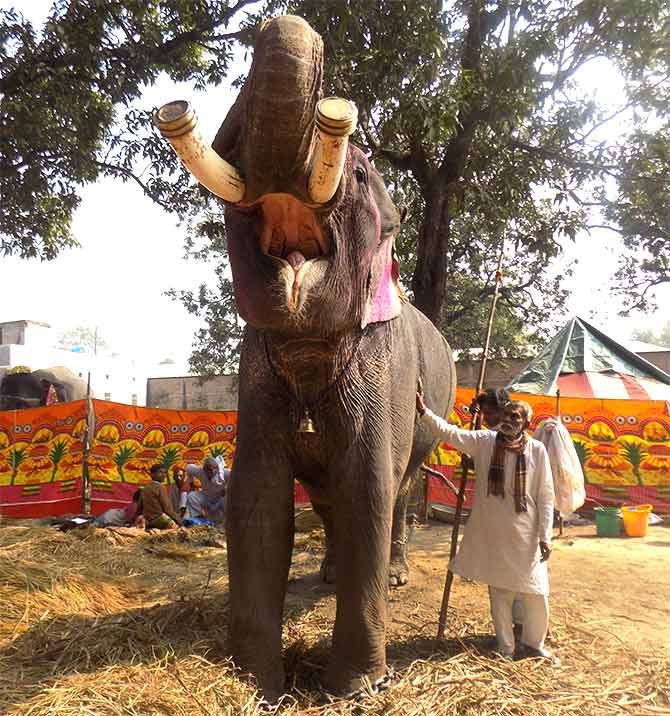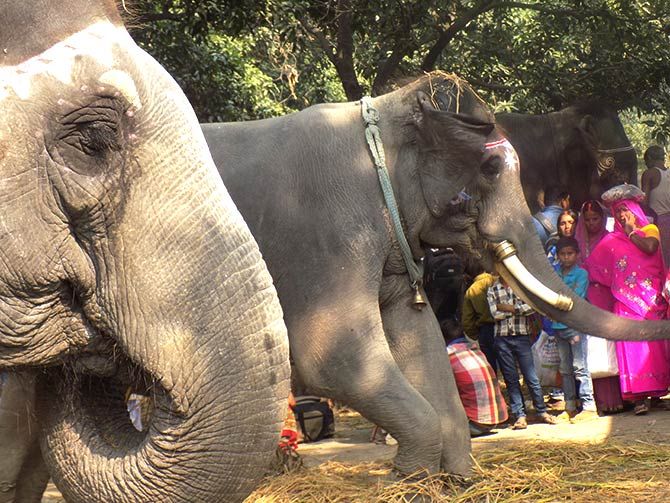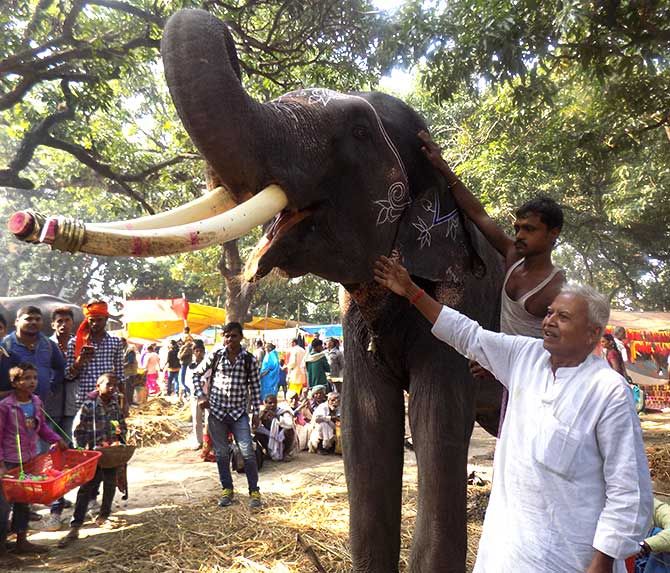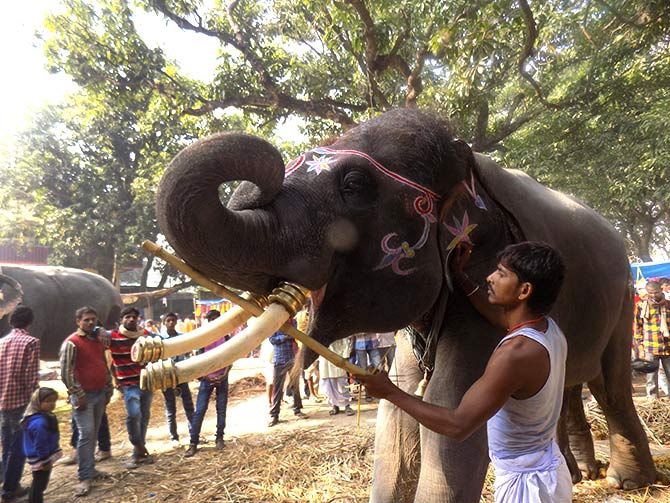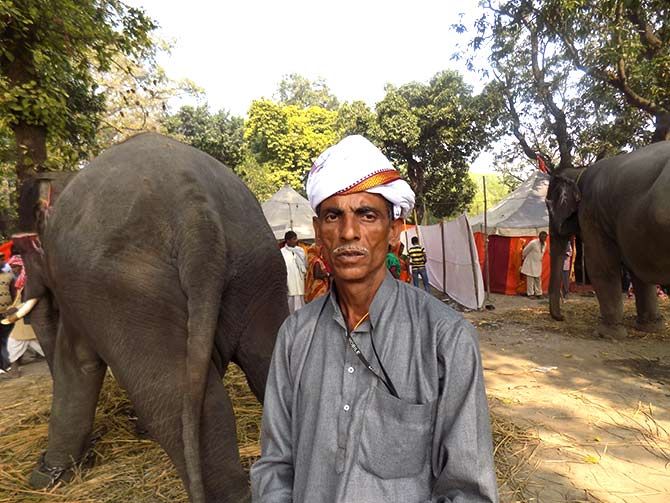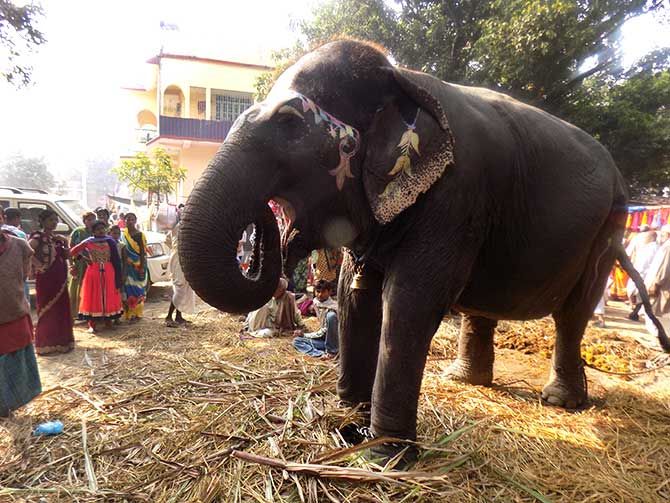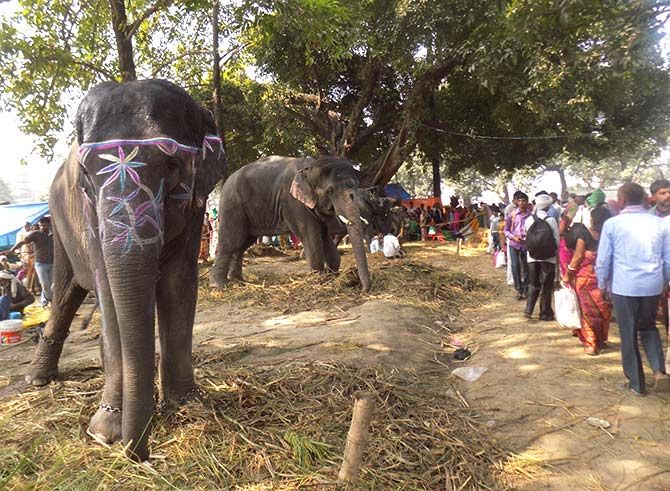Asia's oldest and largest cattle fair may soon lose its star attraction.
Report, Photographs: M I Khan
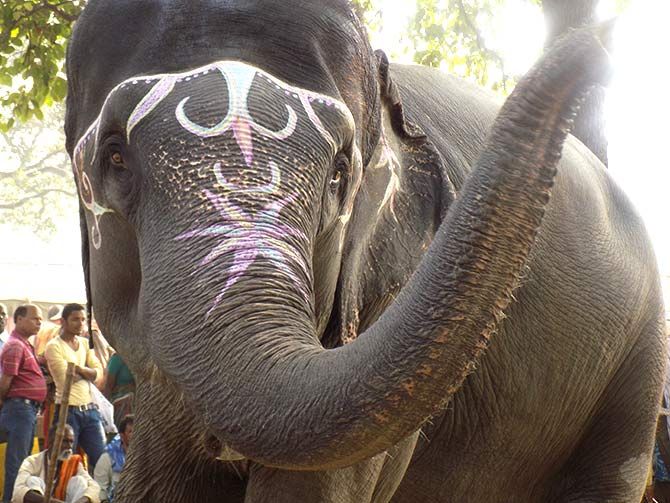
Neighing horses.
Heavy-lidded cattle, chewing on cud.
Frisky goats.
Patient donkeys.
Impatient monkeys.
Playful rabbits and ponies.
Energetic guinea pigs.
Sleepy bears.
Watchful cats.
These are just some of the animals that you spot at the Sonepur cattle fair in Saran, Bihar.
Held in November -- it begins on Kartik Purnima and is held at the confluence of the two rivers, the Ganga and the Gandak -- the fair can stretch anywhere from 15 days to a month.
If you happened to drop by, you would be astounded to find out that this is the oldest, and largest, such cattle fair in Asia.
It is believed to have existed between 340-297 BCE at Hajipur and counted among its august visitors the great Mauryan ruler, Chandragupta.
Later, under Emperor Aurangzeb's rule, the location of the fair was moved to Sonepur.
But this history -- interesting though it is -- is not the Sonepur Mela's biggest attraction.
The credit for that -- you can take this literally if you want -- goes to those magnificent animals, the elephants.
At one time, the Haathi Bazaar, or the elephant market at the Sonepur Mela, would attract hordes of elephant buyers and sellers from across India.
Just the Haathi Bazaar would be spread over a kilometre.
Buyers from Rajasthan, Tamil Nadu and Kerala would walk among the tuskers, choosing the ones they would like to take home.
Today, with the Wildlife Protection Act of 1972 in force -- under its provisions, the sale of elephants was banned in early 2000 -- barely a baker's dozen of the gentle behemoths have made it to the fair.
And they are here for display, not for sale.
The Haathi Bazaar now finds itself confined to 500 hectares, but still pulls its fair share of visitors who include locals, tourists from across the country and foreigners from distant lands.
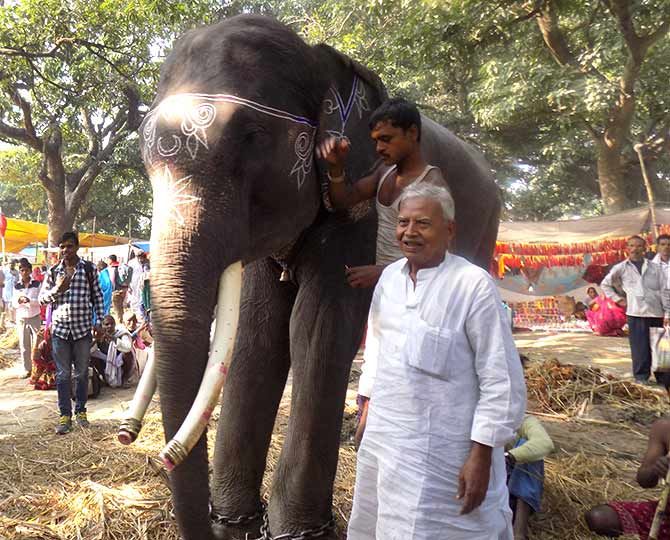
Dressed in a white cotton kurta and dhoti, Brajnandan Singh is here with his haathi, Babusaheb.
The 71 year old has been a regular at the mela since 1960. As a youngster, he would come here along with his father, his uncles and his elder brothers to sell and buy elephants all the way from his village, Ismailpur, in Vaishali district.
Brajnandan recalls how, in the 1960s, the fair would see more than 300 elephants. "This year, only 13 elephants arrived at the fair. It is a big fall from more than 100 elephants in the 1980s, to nearly 100 in the 1990s and below 100 in 2000," he points out.
Singh believes the decreasing number of elephants at Sonepur is depriving the centuries-old mela of its sense of grandeur and may even sound the death knell for one the oldest cattle fairs in the world.
"Despite the fewer number of elephants, Haathi Bazaar is still the most popular attraction here," he says, stroking Babusaheb.
"Elephants are the symbol of the Sonepur fair. Without the elephant, the fair will lose its age-old tradition. The decrease in the number of elephants is a warning bell for the fair," he says sadly.
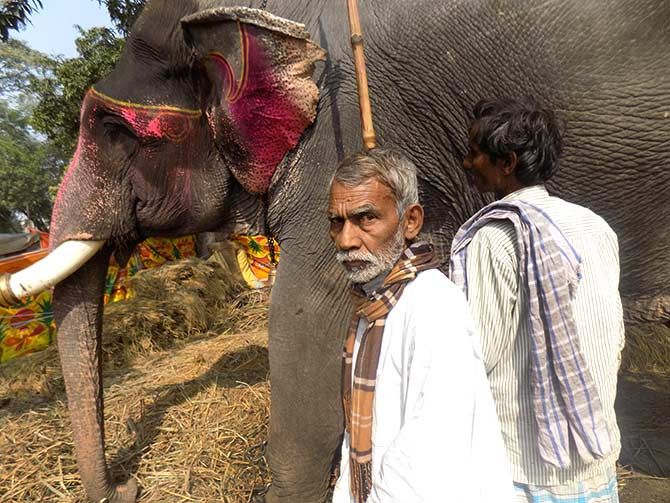
Shyam Bahadur Singh, a Janata Dal-United MLA, agrees. "I have brought my elephant, Gaman, here for the sake of the fair. Unfortunately, due to a wrong decision by the government, the number of elephants in the fair has been decreasing rapidly."
"One cannot imagine the Sonepur fair without the elephants," he adds, "but that might actually happen within 10 or 15 years. If that happens, it would destroy a piece of our history. It would be a tragedy for future generations."
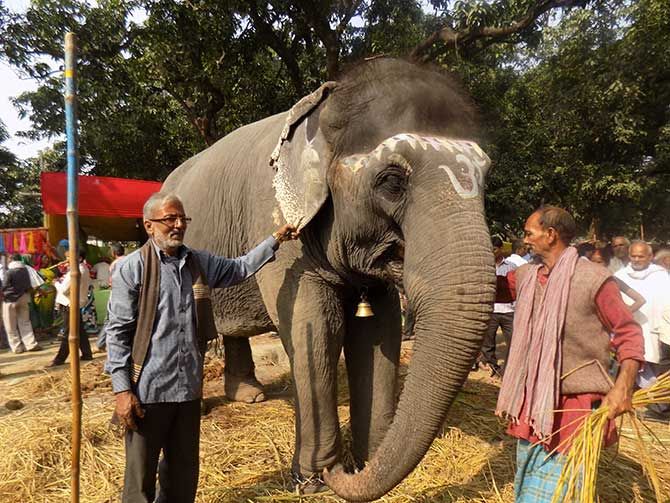
Sanju Singh, who has come here with his female elephant, Gulabi, says the number of elephants at the fair has dwindled after the government banned their sale and transportation from Assam.
"There was a time," he echoes Brajnandan Singh, "when hundreds of elephants were brought for sale here. I have seen it since 1967, when I came here for the first time with my elephant."
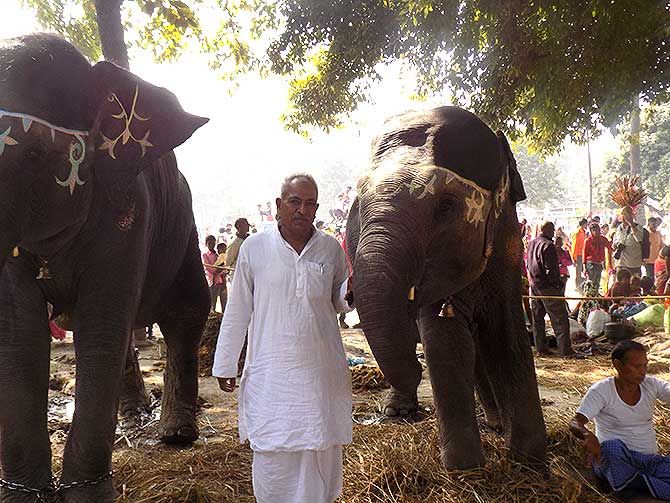
Rama Singh, who has brought his two female elephants -- Durga and Pushpa -- to the fair, too recalls how hundreds of elephants were brought to the fair for sale and purchase till mid-1960s.
"The cost of an elephant then ranged from Rs 2,500 to Rs 3,500," he says.
Rama says he is not an elephant trader. He wants people to love elephants as much as he does -- "I worship Durga and Pushpa every morning," he says -- which is why he displays his haathis at Sonepur.
"Maintaining two elephants is a costly affair and I cannot earn any income from them. Besides, I employ three mahouts. But I keep my elephants because I believe they bring me good luck and prosperity," says the farmer.
Rama comes to the Sonepur fair, with his elephants and mahouts, from Paharpur village in Saran district.
"We have to keep the Haathi Bazaar alive with this annual display of our elephants for tourists and the local people at least," he says.
French citizens, Dominique and his wife Odile, are among the 20 foreign tourists who made it to Haathi Bazaar this year. "It's an amazing feeling to be able to touch an elephant," says 68-year-old Dominique. "We don't have elephants in our country."

Both Brajnandan Singh and Sanju Singh agree that the next generation is not interested in maintaining elephants.
"Hamare baad shayed haathi hamare ghar mein na rahein... kaun palega (After me, no one will keep an elephant in our home... Who'll take the responsibility of looking after them?)" he asks.
Brajnandan Singh's family of three brothers and their six sons is now scattered, with the children having left their ancestral village after their education to establish their individual businesses.
"Haathi aaj bhi ghar ka shaan hai. Agar hum nahin rakhenge, toh woh samapth ho jayega (Even today, the elephant is a symbol of our pomp. If I don't keep an elephant, this tradition will end)," he says. "No one in our family is keen to keep alive this decades-old tradition."
The prospect of this occurrence clouds his face.
"An elephant is unique; it's special. A man may have SUVs, but it can't equal an elephant. In rural Bihar, people in a district know which family owns an elephant. It is a matter of honour, respect and prestige if an elephant is tied in front of your house," says Brajnandan Singh, who used to be the headman of his village.
"It is a costly passion and the utility of the big animal has dwindled in the age of mobile phones and the Internet," says Sanju Singh.

Maintaining an elephant, says Brajnandan Singh, "costs more than the costliest SUV. An elephant consumes at least 5 kilos of wheat or paddy, sugarcane and grass every day."
Patting Babusaheb fondly, he says, "In addition, he wants 7 to 8 loaves of bread every night. He will cry if he is not provided with the bread."
To take care of Babusaheb, he has hired two mahouts, "Each of them is paid Rs 2,500 a month. I also take care of their food and clothing expenses."
The family, he says, owns over 100 bighas of farmland which helps him take care of these expenses.
Sanju Singh, who lives in Deoria, Uttar Pradesh, too owns a large tract of farmland that helps him maintain his elephant.
"My family has been domesticating elephants for over a century," says Dr Jyoti Kumar from Jandaha in Vaishali district. "Today, only the affluent can maintain their family tradition of keeping elephants."
There are, he says, more than 50 domesticated elephants across Bihar, many of which are in Saran.
"I have come here with my elephant, Appu, so that visitors to the fair can enjoy taking photographs and selfies with him," Dr Kumar says.
Some more glimpses from the Sonepur Mela.
